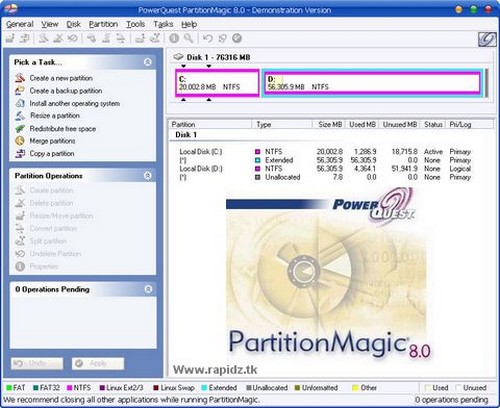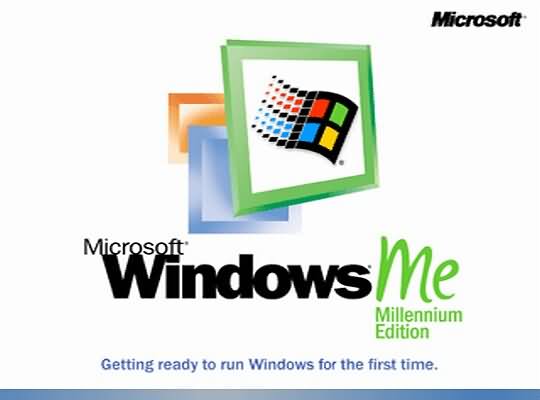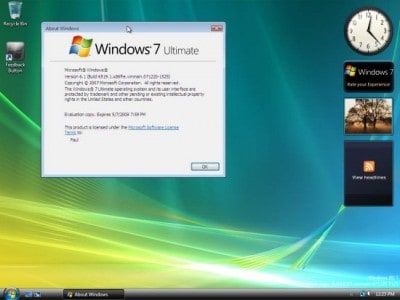Image from images.tothetech.com
As expected, I downloaded the Advisor, installed it and ran it, and I was more than happy to know that I can upgrade to Windows 7, only that I should install the 32-bit version instead of the 64-bit one. Well, that is okay because I have both versions.
Image from hdd-tool.com
Image from intelliadmin.com
While I was doing that, a question just popped up in my head, "Why can't I have both Windows XP and 7 on the same hard disk?" I have tried to install 2 Windows ME on the same hard disk, and then later 2 Windows XP on two separate hard disks, though there was not much point doing that, there is a good reason I do this now. As I know that there are still quite a number of software not compatible with Windows 7, so keeping Windows XP allows me to ensure I can still work smoothly if anything goes wrong with the installation.
Now, this is called "Dual-booting".
Image from instructables.com
The first thing to do then, was to create a new Primary Partition for Windows 7 to be installed later, and also hide the current Windows XP partition, then reboot system.
To cut short the story, the installation was quick and smooth, and the installation program was smart enough to download all the most updated drivers from the internet and saved me from lots of hassle. (But soon after that I realised the hiding of the partitions was unnecessary because Windows 7 is too smart.)
Image from blogsdna.com
In no time, I was running on Windows 7. But let's not forget, my goal was to be able to choose which Windows to run when I wanted, and with my data partition and XP partition hidden, I need to unhide them, now how do I do that?
- I could either install PM8 on my Windows 7 first, but no guarantee it will work on the 7, or,
- I could make use of my Windows PE, a home-made Windows ME that allows you to run Windows using just the RAM (well, not really, but more or less true), which includes PM8 and other cool disk manager softwares inside.
 |
| Image from Google |
But now what? Will your computer now knows that you have 2 different Windows on the same hard disk and so let you choose which one you want to use?
That depends on your luck. Windows 7 has a Windows Boot Manager at startup, but if it doesn't come out, then you'll need to install something called the (second-stage) boot loader, in this case, I used EasyBCD.
Image from wiki.wegotserved.com
Following the instructions I found from the internet (please see links below), and Ho Ho Ho!!! I can now choose which ever Windows I want to boot! Hurray!!!!
After installing all the usual software I often use, I have figured out a new challenge, which I will share some time after accomplishing, or failing......
(To be continued)
Vocabulary:
Dual-boot / Dual-booting -- Multi-boot or Multi-booting is the act of installing multiple operating systems on a computer, and being able to choose which one to boot when starting the computer. The term dual-booting refers to the common configuration of exactly two operating systems.
hassle -- [C or U] informal (a situation causing) difficulty or trouble
boot loader -- a software that loads the main operating system for the computer.
Resources:
http://lockyep.blogspot.com/2010/09/technology-window-7-now.html
http://www.microsoft.com/windows/windows-7/get/upgrade-advisor.aspx
http://en.wikipedia.org/wiki/Dual_booting
http://en.wikipedia.org/wiki/Booting
http://en.wikipedia.org/wiki/Booting#Second-stage_boot_loader
http://en.wikipedia.org/wiki/EasyBCD
http://dictionary.cambridge.org/dictionary/british/hassle_1
For a video guide instead of reading what I am writing:
http://technet.microsoft.com/en-us/edge/dual-boot-between-windows-xp-and-windows-7.aspx
On detail use of Disk Management:
On using EasyBCD:
http://www.howtogeek.com/howto/8790/dual-boot-your-pre-installed-windows-7-computer-with-xp/







No comments:
Post a Comment